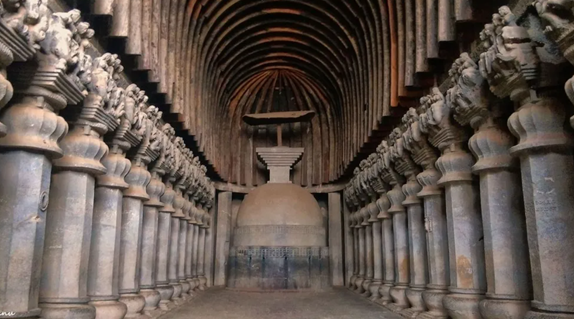

Context
The ASI recently demanded that the district administration remove the encroachments near Ekvira Devi temple which is close to Karla caves.
About
About Karla Caves:
- Location: Situated around 8 km from Bhaja, near Lonavala.
- The rock-cut Buddhist Karla Caves believed to date back to the 1st century BC.
- The rock cut architecture, such as the Petra in Jordan, are structures that are created by cutting into sheer rock faces.
|
- They are remarkable because they have the biggest and best-preserved prayer hall in India.
- The Karla Caves were once a Buddhist monastery and consist of 16 excavations/caves.
- Most of the caves belong to the early Hinayana phase of Buddhism, except for three from the later Mahayana phase.
- Chaityagriha: Main Cave: The main cave is the huge prayer/assembly hall, known as a chaityagriha, that's believed to date back to the 1st century BC.
- It has a magnificent roof made out of carved teak wood, rows of pillars decorated with sculptures of men, women, elephants, and horses, and a large sun window at the entrance that deflects rays of light towards the stupa at the rear.
- Viharas: The other 15 excavations are much smaller monastery living and prayer spaces, known as
|
Dynasty
|
- Temples carved in the natural cliff were especially well suited for Indian conditions and prescriptions of Buddhists – they were cool in summer, pleasant in winter, and spiritually were part of nature.
Architecture
- Karla Caves represent the highest achievement of Indian rock-cut architecture of the time and are one of the earliest examples of ornate and richly decorated rock-cut temples in India.
- The earlier caves were made by the more ancient branch of Buddhists – Theravada Buddhists.
- Back then images of Buddha were not used in temple architecture. Later – Mahayana Buddhist temples from the 5th to the 10th century – include statues of Buddha.
- The architecture of earlier cave temples in many respects repeats the elements and construction of wooden architecture.
- Karla Caves are characterized by large horseshoe-shaped windows lighting the interiors and vaulted interiors.

|
Archaeological Survey of India (ASI)
|


